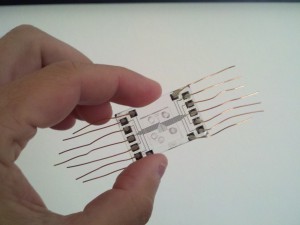Researchers at UT have developed a new desalination method that uses electrochemistry to make drinking water from seawater.
Led by UT chemistry professor Richard Crooks, the team works using a small electric field to separate salt from seawater. Working with researchers from the University of Marburg in Germany, Crooks and his team developed a small plastic chip, known as a “WaterChip,” that performs the process on a microscale. The team believes their technique, electrochemically mediated seawater desalination, could provide a simpler and more energy-efficient alternative to conventional methods such as reverse osmosis.
“When you talk about desalination, you have to talk about the energy efficiency. And that’s really one of the benefits of the technique we’ve created,” Kyle Knust, a graduate student working on the project, said. “When you compare energy efficiencies, we’re only slightly above the [minimum] amount of energy you need to drive the desalination process. This is why this is so interesting.”
Okeanos Technologies, a startup company in Kentucky, is now working on scaling-up the WaterChip design in order to put the new method into commercial use. Tony Frudakis, the company’s founder and CEO, approached Crooks more than a year ago about adapting his molecule purification method for seawater desalination and helped secure funding for the research. Frudakis expects the company to have its first prototype ready by the end of the year.
“We believe this technology has the potential to be the first breakthrough in desalination since the 1950s,” Frudakis said. “It’s already desalinating at very low scales with world record efficiency.”
If the technology can be scaled up, Frudakis believes it has the potential to not only replace reverse osmosis as the lead desalination method, but provide water to places where drinkable water is a limited resource.
“Right now the problem is that we can get drinking water from saltwater, but the technology is very energy-great and extensive,” Frudakis said. “If there were a method to desalinate that was cost effective, a lot of the dynamics could be changed. Desalination could take place where it’s needed most desperately.”
Besides the scaling-up process, the method itself also needs to be improved before it can be implemented commercially. According to Knust, the method currently removes 25 percent of salt from seawater. Frudakis and his team must work on improving the salt rejection rate to 99 percent. However, Knust believes that once that is achieved, the technology could solve a lot of problems related to water access.
“There’s a need for seawater desalination. Everyone needs water,” Knust said. “Seawater accounts for 97 and a half percent of all the water on Earth. If you could start accessing that, you can envision how big of a sink of freshwater that could be.”
Follow Jacob Kerr on Twitter @jacobrkerr





















